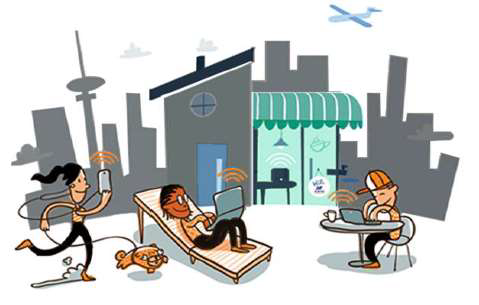
- Wireless Communication - Home
- Wireless Communication - Overview
- Terms in Mobile Telephony
- Multiple Access
- Channel Characteristics
- Wireless Communication - TCP/IP
- Cellular Wireless Networks
- Propagation Losses
- Techniques
- Wireless Communication - WAN
- Bluetooth
- Wireless Communication - Internet
- Wireless Communication - WAP
- Wireless Communication - Satellite
Wireless Communication - Overview
Wireless communication involves the transmission of information over a distance without the help of wires, cables or any other forms of electrical conductors.
Wireless communication is a broad term that incorporates all procedures and forms of connecting and communicating between two or more devices using a wireless signal through wireless communication technologies and devices.
Features of Wireless Communication
The evolution of wireless technology has brought many advancements with its effective features.
The transmitted distance can be anywhere between a few meters (for example, a television's remote control) and thousands of kilometers (for example, radio communication).
Wireless communication can be used for cellular telephony, wireless access to the internet, wireless home networking, and so on.
Other examples of applications of radio wireless technology include GPS units, garage door openers, wireless computer mice, keyboards and headsets, headphones, radio receivers, satellite television, broadcast television and cordless telephones.

Wireless - Advantages
Wireless communication involves transfer of information without any physical connection between two or more points. Because of this absence of any 'physical infrastructure', wireless communication has certain advantages. This would often include collapsing distance or space.
Wireless communication has several advantages; the most important ones are discussed below −
Cost effectiveness
Wired communication entails the use of connection wires. In wireless networks, communication does not require elaborate physical infrastructure or maintenance practices. Hence the cost is reduced.
Example − Any company providing wireless communication services does not incur a lot of costs, and as a result, it is able to charge cheaply with regard to its customer fees.
Flexibility
Wireless communication enables people to communicate regardless of their location. It is not necessary to be in an office or some telephone booth in order to pass and receive messages.
Miners in the outback can rely on satellite phones to call their loved ones, and thus, help improve their general welfare by keeping them in touch with the people who mean the most to them.
Convenience
Wireless communication devices like mobile phones are quite simple and therefore allow anyone to use them, wherever they may be. There is no need to physically connect anything in order to receive or pass messages.
Example − Wireless communications services can also be seen in Internet technologies such as Wi-Fi. With no network cables hampering movement, we can now connect with almost anyone, anywhere, anytime.
Speed
Improvements can also be seen in speed. The network connectivity or the accessibility were much improved in accuracy and speed.
Example − A wireless remote can operate a system faster than a wired one. The wireless control of a machine can easily stop its working if something goes wrong, whereas direct operation cant act so fast.
Accessibility
The wireless technology helps easy accessibility as the remote areas where ground lines cant be properly laid, are being easily connected to the network.
Example − In rural regions, online education is now possible. Educators no longer need to travel to far-flung areas to teach their lessons. Thanks to live streaming of their educational modules.
Constant connectivity
Constant connectivity also ensures that people can respond to emergencies relatively quickly.
Example − A wireless mobile can ensure you a constant connectivity though you move from place to place or while you travel, whereas a wired land line cant.